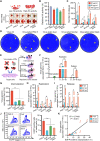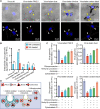Airborne fine particles drive H1N1 viruses deep into the lower respiratory tract and distant organs
- PMID: 37294770
- PMCID: PMC10256160
- DOI: 10.1126/sciadv.adf2165
Airborne fine particles drive H1N1 viruses deep into the lower respiratory tract and distant organs
Abstract
Mounting data suggest that environmental pollution due to airborne fine particles (AFPs) increases the occurrence and severity of respiratory virus infection in humans. However, it is unclear whether and how interactions with AFPs alter viral infection and distribution. We report synergetic effects between various AFPs and the H1N1 virus, regulated by physicochemical properties of the AFPs. Unlike infection caused by virus alone, AFPs facilitated the internalization of virus through a receptor-independent pathway. Moreover, AFPs promoted the budding and dispersal of progeny virions, likely mediated by lipid rafts in the host plasma membrane. Infected animal models demonstrated that AFPs favored penetration of the H1N1 virus into the distal lung, and its translocation into extrapulmonary organs including the liver, spleen, and kidney, thus causing severe local and systemic disorders. Our findings revealed a key role of AFPs in driving viral infection throughout the respiratory tract and beyond. These insights entail stronger air quality management and air pollution reduction policies.
Figures








Similar articles
-
Lianhuaqingwen capsule inhibits non-lethal doses of influenza virus-induced secondary Staphylococcus aureus infection in mice.J Ethnopharmacol. 2022 Nov 15;298:115653. doi: 10.1016/j.jep.2022.115653. Epub 2022 Aug 19. J Ethnopharmacol. 2022. PMID: 35995276
-
Lower Respiratory Tract Infection of the Ferret by 2009 H1N1 Pandemic Influenza A Virus Triggers Biphasic, Systemic, and Local Recruitment of Neutrophils.J Virol. 2015 Sep;89(17):8733-48. doi: 10.1128/JVI.00817-15. Epub 2015 Jun 10. J Virol. 2015. PMID: 26063430 Free PMC article.
-
Sequential Transmission of Influenza Viruses in Ferrets Does Not Enhance Infectivity and Does Not Predict Transmissibility in Humans.mBio. 2022 Dec 20;13(6):e0254022. doi: 10.1128/mbio.02540-22. Epub 2022 Oct 27. mBio. 2022. PMID: 36300929 Free PMC article.
-
Assembly and budding of influenza virus.Virus Res. 2004 Dec;106(2):147-65. doi: 10.1016/j.virusres.2004.08.012. Virus Res. 2004. PMID: 15567494 Free PMC article. Review.
-
Viral pathogens and acute lung injury: investigations inspired by the SARS epidemic and the 2009 H1N1 influenza pandemic.Semin Respir Crit Care Med. 2013 Aug;34(4):475-86. doi: 10.1055/s-0033-1351122. Epub 2013 Aug 11. Semin Respir Crit Care Med. 2013. PMID: 23934716 Free PMC article. Review.
Cited by
-
Nanoparticle-Exposure-Triggered Virus Reactivation Induces Lung Emphysema in Mice.ACS Nano. 2023 Nov 14;17(21):21056-21072. doi: 10.1021/acsnano.3c04111. Epub 2023 Oct 19. ACS Nano. 2023. PMID: 37856828 Free PMC article.
-
Global meta-analysis of short-term associations between ambient temperature and pathogen-specific respiratory infections, 2004 to 2023.Euro Surveill. 2025 Mar;30(11):2400375. doi: 10.2807/1560-7917.ES.2025.30.11.2400375. Euro Surveill. 2025. PMID: 40116032 Free PMC article. Review.
-
Particulate matter air pollution: effects on the respiratory system.J Clin Invest. 2025 Sep 2;135(17):e194312. doi: 10.1172/JCI194312. eCollection 2025 Sep 2. J Clin Invest. 2025. PMID: 40892514 Free PMC article. Review.
-
Lung megakaryocytes engulf inhaled airborne particles to promote intrapulmonary inflammation and extrapulmonary distribution.Nat Commun. 2024 Aug 27;15(1):7396. doi: 10.1038/s41467-024-51686-y. Nat Commun. 2024. PMID: 39191805 Free PMC article.
-
Microbial Dysbiosis in the Lung and Gut in Response to Inhalable Particulate Matters in Pneumoconiosis Patients and Animals.Environ Sci Technol. 2025 Jun 10;59(22):10826-10840. doi: 10.1021/acs.est.5c00798. Epub 2025 May 29. Environ Sci Technol. 2025. PMID: 40439217 Free PMC article.
References
-
- Kogevinas M., Castaño-Vinyals G., Karachaliou M., Espinosa A., de Cid R., Garcia-Aymerich J., Carreras A., Cortés B., Pleguezuelos V., Jiménez A., Vidal M., O’Callaghan-Gordo C., Cirach M., Santano R., Barrios D., Puyol L., Rubio R., Izquierdo L., Nieuwenhuijsen M., Dadvand P., Aguilar R., Moncunill G., Dobaño C., Tonne C., Ambient air pollution in relation to SARS-CoV-2 infection, antibody response, and COVID-19 disease: A cohort study in Catalonia, Spain (COVICAT Study). Environ. Health Perspect. 129, 117003 (2021). - PMC - PubMed
-
- Dolci M., Favero C., Bollati V., Campo L., Cattaneo A., Bonzini M., Villani S., Ticozzi R., Ferrante P., Delbue S., Particulate matter exposure increases JC polyomavirus replication in the human host. Environ. Pollut. 241, 234–239 (2018). - PubMed
MeSH terms
Substances
LinkOut - more resources
Full Text Sources
Medical

